更多博客文章,欢迎 Star Github/Blog
Javascript 代码的解析(Parse )步骤分为两个阶段:词法分析(Lexical Analysis) 和 语法分析(Syntactic Analysis)。这个步骤接收代码并输出 抽象语法树,亦称 AST。
随着 Babel 的生态越来越完善,我们通常会使用 Babel 来帮助我们分析代码的解析过程。Babel 使用一个基于 ESTree 并修改过的 AST,它的内核说明文档可以在 这里. com/babel/babel/blob/master/doc/ast/spec. md) 找到。
在分析 Javascript 的 AST 过程中,借助于工具 AST Explorer 能帮助我们对 AST 节点有一个更好的感性认识。
为了帮助大家更好的结合实例分析,了解核心的 Babylon AST node types 组成,这里列举了 13 个常用例子,并分别列出了对应的 AST 节点及详细的 node types 解析。
以下所有的代码的 AST 全部基于 Babylon7
变量声明
代码
let a = 'hello'AST
VariableDeclaration
变量声明,kind 属性表示是什么类型的声明,因为 ES6 引入了 const/let。declarations 表示声明的多个描述,因为我们可以这样:let a = 1, b = 2;。
interface VariableDeclaration <: Declaration {
type: "VariableDeclaration";
declarations: [ VariableDeclarator ];
kind: "var";
}VariableDeclarator
变量声明的描述,id 表示变量名称节点,init 表示初始值的表达式,可以为 null。
interface VariableDeclarator <: Node {
type: "VariableDeclarator";
id: Pattern;
init: Expression | null;
} Identifier
标识符,我觉得应该是这么叫的,就是我们写 JS 时自定义的名称,如变量名,函数名,属性名,都归为标识符。相应的接口是这样的:
interface Identifier <: Expression, Pattern {
type: "Identifier";
name: string;
}一个标识符可能是一个表达式,或者是解构的模式(ES6 中的解构语法)。我们等会会看到 Expression 和 Pattern 相关的内容的。
Literal
字面量,这里不是指 [] 或者 {} 这些,而是本身语义就代表了一个值的字面量,如 1,“hello”, true 这些,还有正则表达式(有一个扩展的 Node 来表示正则表达式),如 /\d?/。我们看一下文档的定义:
interface Literal <: Expression {
type: "Literal";
value: string | boolean | null | number | RegExp;
}value 这里即对应了字面量的值,我们可以看出字面量值的类型,字符串,布尔,数值,null 和正则。
二元运算表达式
代码
let a = 3+4AST
BinaryExpression
二元运算表达式节点,left 和 right 表示运算符左右的两个表达式,operator 表示一个二元运算符。
interface BinaryExpression <: Expression {
type: "BinaryExpression";
operator: BinaryOperator;
left: Expression;
right: Expression;
}BinaryOperator
二元运算符,所有值如下:
enum BinaryOperator {
"==" | "!=" | "===" | "!=="
| "<" | "<=" | ">" | ">="
| "<<" | ">>" | ">>>"
| "+" | "-" | "*" | "/" | "%"
| "|" | "^" | "&" | "in"
| "instanceof"
}赋值表达式
代码
这个例子会稍微复杂一点,涉及到的 Node 类型比较多。
this.state = {date: new Date()};AST
ExpressionStatement
表达式语句节点,a = a + 1 或者 a++ 里边会有一个 expression 属性指向一个表达式节点对象(后边会提及表达式)。
interface ExpressionStatement <: Statement {
type: "ExpressionStatement";
expression: Expression;
}AssignmentExpression
赋值表达式节点,operator 属性表示一个赋值运算符,left 和 right 是赋值运算符左右的表达式。
interface AssignmentExpression <: Expression {
type: "AssignmentExpression";
operator: AssignmentOperator;
left: Pattern | Expression;
right: Expression;
}AssignmentOperator
赋值运算符,所有值如下:(常用的并不多)
enum AssignmentOperator {
"=" | "+=" | "-=" | "*=" | "/=" | "%="
| "<<=" | ">>=" | ">>>="
| "|=" | "^=" | "&="
}MemberExpression
成员表达式节点,即表示引用对象成员的语句,object 是引用对象的表达式节点,property 是表示属性名称,computed 如果为 false,是表示 . 来引用成员,property 应该为一个 Identifier 节点,如果 computed 属性为 true,则是 [] 来进行引用,即 property 是一个 Expression 节点,名称是表达式的结果值。
interface MemberExpression <: Expression, Pattern {
type: "MemberExpression";
object: Expression;
property: Expression;
computed: boolean;
}ThisExpression
表示 this。
interface ThisExpression <: Expression {
type: "ThisExpression";
}ObjectExpression
对象表达式节点,property 属性是一个数组,表示对象的每一个键值对,每一个元素都是一个属性节点。
interface ObjectExpression <: Expression {
type: "ObjectExpression";
properties: [ Property ];
}Property
对象表达式中的属性节点。key 表示键,value 表示值,由于 ES5 语法中有 get/set 的存在,所以有一个 kind 属性,用来表示是普通的初始化,或者是 get/set。
interface Property <: Node {
type: "Property";
key: Literal | Identifier;
value: Expression;
kind: "init" | "get" | "set";
}NewExpression
new 表达式。
interface NewExpression <: CallExpression {
type: "NewExpression";
}函数调用表达式
代码
console.log(`Hello ${name}`)AST
CallExpression
函数调用表达式,即表示了 func(1, 2) 这一类型的语句。callee 属性是一个表达式节点,表示函数,arguments 是一个数组,元素是表达式节点,表示函数参数列表。
interface CallExpression <: Expression {
type: "CallExpression";
callee: Expression;
arguments: [ Expression ];
}TemplateLiteral
interface TemplateLiteral <: Expression {
type: "TemplateLiteral";
quasis: [ TemplateElement ];
expressions: [ Expression ];
}TemplateElement
interface TemplateElement <: Node {
type: "TemplateElement";
tail: boolean;
value: {
cooked: string | null;
raw: string;
};
}箭头函数
代码
i => i++AST
ArrowFunctionExpression
箭头函数表达式。
interface ArrowFunctionExpression <: Function, Expression {
type: "ArrowFunctionExpression";
body: BlockStatement | Expression;
expression: boolean;
}UpdateExpression
update 运算表达式节点,即 ++/--,和一元运算符类似,只是 operator 指向的节点对象类型不同,这里是 update 运算符。
interface UpdateExpression <: Expression {
type: "UpdateExpression";
operator: UpdateOperator;
argument: Expression;
prefix: boolean;
}UpdateOperator
update 运算符,值为 ++ 或 --,配合 update 表达式节点的 prefix 属性来表示前后。
enum UpdateOperator {
"++" | "--"
}函数声明
代码
function Hello(name = 'Lily'){
}AST
FunctionDeclaration
函数声明,和之前提到的 Function 不同的是,id 不能为 null。
interface FunctionDeclaration <: Function, Declaration {
type: "FunctionDeclaration";
id: Identifier;
}AssignmentPattern
interface AssignmentPattern <: Pattern {
type: "AssignmentPattern";
left: Pattern;
right: Expression;
}BlockStatement
块语句节点,举个例子:if (...) { // 这里是块语句的内容 },块里边可以包含多个其他的语句,所以有一个 body 属性,是一个数组,表示了块里边的多个语句。
interface BlockStatement <: Statement {
type: "BlockStatement";
body: [ Statement ];
}类声明
代码
class Clock extends Component{
render(){
}
}AST
Classes
interface Class <: Node {
id: Identifier | null;
superClass: Expression | null;
body: ClassBody;
decorators: [ Decorator ];
}ClassBody
interface ClassBody <: Node {
type: "ClassBody";
body: [ ClassMethod | ClassPrivateMethod | ClassProperty | ClassPrivateProperty ];
}ClassMethod
interface ClassMethod <: Function {
type: "ClassMethod";
key: Expression;
kind: "constructor" | "method" | "get" | "set";
computed: boolean;
static: boolean;
decorators: [ Decorator ];
}if 语句
代码
if(a === 0){
}AST
IfStatement
if 语句节点,很常见,会带有三个属性,test 属性表示 if (...) 括号中的表达式。
consequent 属性是表示条件为 true 时的执行语句,通常会是一个块语句。
alternate 属性则是用来表示 else 后跟随的语句节点,通常也会是块语句,但也可以又是一个 if 语句节点,即类似这样的结构:if (a) { //... } else if (b) { // ... }。alternate 当然也可以为 null。
interface IfStatement <: Statement {
type: "IfStatement";
test: Expression;
consequent: Statement;
alternate: Statement | null;
}switch 语句
代码
switch(num){
case 0:
x = 'Sunday'
break;
default:
x = 'Weekday'
}AST
SwitchStatement
switch 语句节点,有两个属性,discriminant 属性表示 switch 语句后紧随的表达式,通常会是一个变量,cases 属性是一个 case 节点的数组,用来表示各个 case 语句。
interface SwitchStatement <: Statement {
type: "SwitchStatement";
discriminant: Expression;
cases: [ SwitchCase ];
}SwitchCase
switch 的 case 节点。test 属性代表这个 case 的判断表达式,consequent 则是这个 case 的执行语句。
当 test 属性是 null 时,则是表示 default 这个 case 节点。
interface SwitchCase <: Node {
type: "SwitchCase";
test: Expression | null;
consequent: [ Statement ];
}for 语句
代码
for (var i = 0; i < 9; i++) {
}AST
ForStatement
for 循环语句节点,属性 init/test/update 分别表示了 for 语句括号中的三个表达式,初始化值,循环判断条件,每次循环执行的变量更新语句(init 可以是变量声明或者表达式)。这三个属性都可以为 null,即 for(;;){}。body 属性用以表示要循环执行的语句。
interface ForStatement <: Statement {
type: "ForStatement";
init: VariableDeclaration | Expression | null;
test: Expression | null;
update: Expression | null;
body: Statement;
}模块引入
代码
import React from 'react'AST
ImportDeclaration
模块声明。
interface ImportDeclaration <: ModuleDeclaration {
type: "ImportDeclaration";
specifiers: [ ImportSpecifier | ImportDefaultSpecifier | ImportNamespaceSpecifier ];
source: Literal;
}ImportDefaultSpecifier
interface ImportDefaultSpecifier <: ModuleSpecifier {
type: "ImportDefaultSpecifier";
}模块导出
代码
export default ClockAST
ExportDefaultDeclaration
interface OptFunctionDeclaration <: FunctionDeclaration {
id: Identifier | null;
}
interface OptClasDeclaration <: ClassDeclaration {
id: Identifier | null;
}
interface ExportDefaultDeclaration <: ModuleDeclaration {
type: "ExportDefaultDeclaration";
declaration: OptFunctionDeclaration | OptClassDeclaration | Expression;
}JSX render 方法
代码:
render() {
return (
<div>
<h1>Hello, world!</h1>
<h2>It is {this.state.date.toLocaleTimeString()}.</h2>
</div>
);
}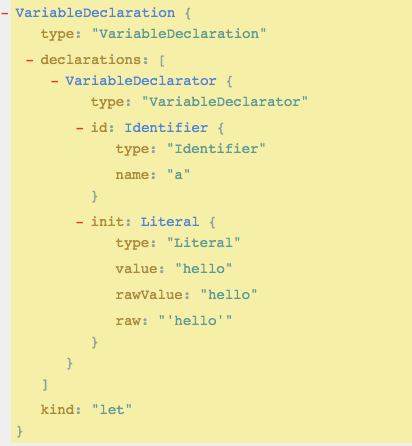
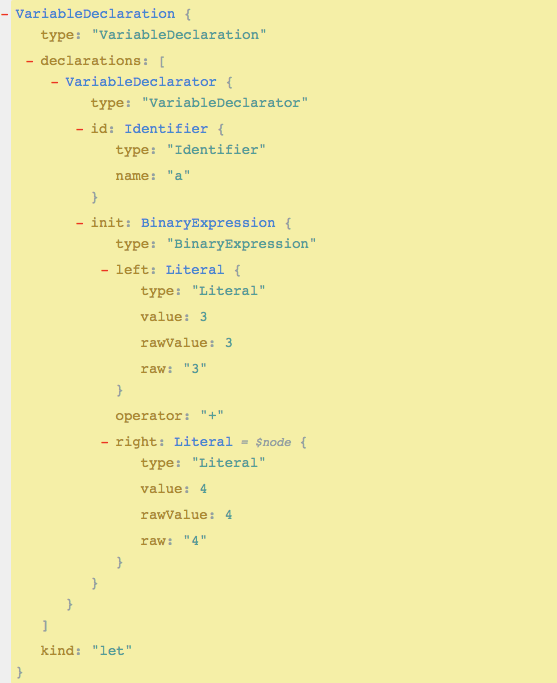
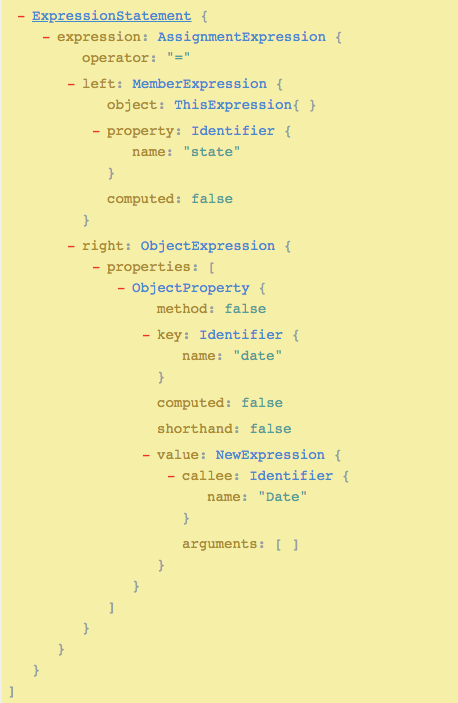
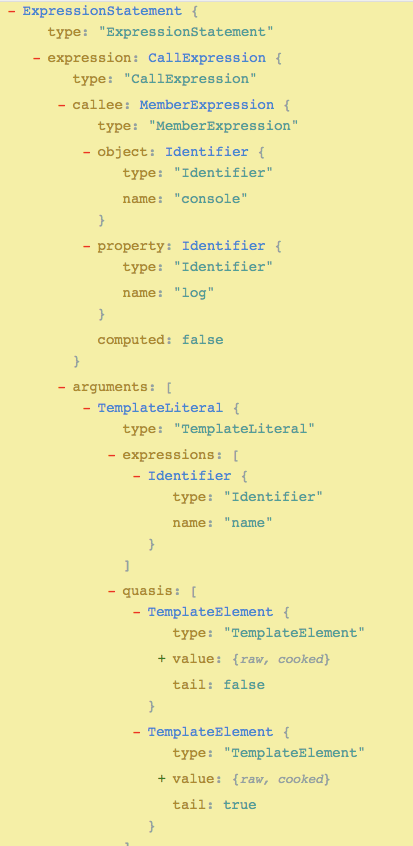



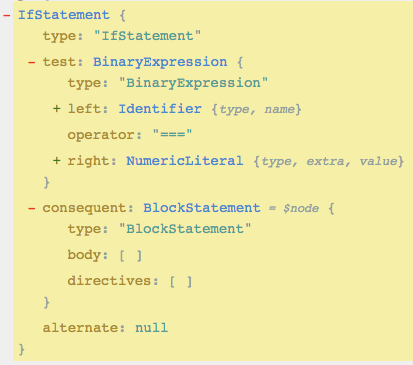
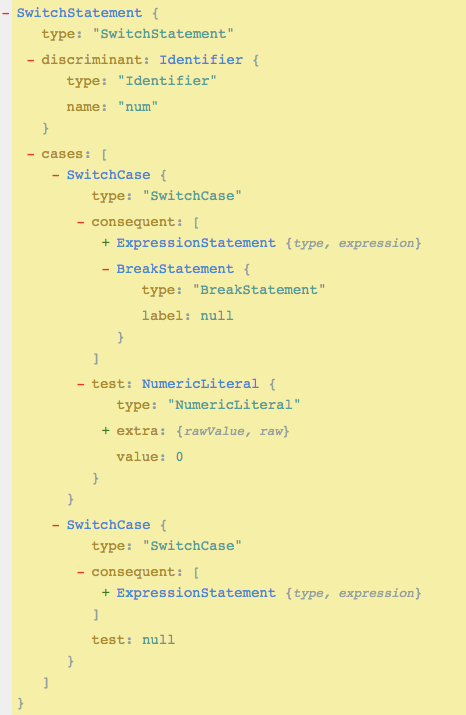





**粗体** _斜体_ [链接](http://example.com) `代码` - 列表 > 引用。你还可以使用@来通知其他用户。